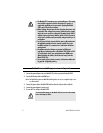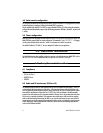
4 Model 3202 Quick Start Guide
2.2 Serial console configuration
For configuring the Model 3202 through the serial console, connect a terminal or a PC equipped with a terminal-
emulation program (such as Hyper Terminal) to the Model 3202's console port.
Use the supplied serial cable (RJ-45 to DB9F) to connect the Model 3202 to a PC. After marking the connection,
configure the terminal-emulation program using the following parameters: 9600 bps , 8 data bits , no parity and
1 stop bit.
2.3 Telnet configuration
Make sure that an Ethernet Adapter has been installed in the PC or NB you will use to configure the modem. The
Model 3202 also supports Telnet for remote configuration. The command is “telnet 192.168.1.1” . For logging
into the system through a Telnet connection, “admin” for username and “admin” for password.
The default IP address is 192.168.1.1. You may change the IP address for your application.
3.0 Additional information
For detailed information about installing, configuring, operating, and troubleshooting your Model 3202, refer to
the Model 3202 User Manual available online at www.patton.com/manuals/3202.pdf.
A.0 Compliance Information
A.1 Compliance
EMC:
•
FCC Part 15, Class A
•
EN55022, Class A
•
EN55024
A.2 Radio and TV Interference (FCC Part 15)
This equipment generates and uses radio frequency energy, and if not installed and used properly—that is, in
strict accordance with the manufacturer's instructions—may cause interference to radio and television recep-
tion. This equipment has been tested and found to comply with the limits for a Class A computing device in accor-
dance with the specifications in Subpart B of Part 15 of FCC rules, which are designed to provide reasonable
protection from such interference in a commercial installation. However, there is no guarantee that interference
will not occur in a particular installation. If the equipment causes interference to radio or television reception,
which can be determined by disconnecting the cables, try to correct the interference by one or more of the fol-
lowing measures: moving the computing equipment away from the receiver, re-orienting the receiving antenna,
and/or plugging the receiving equipment into a different AC outlet (such that the computing equipment and
receiver are on different branches).










